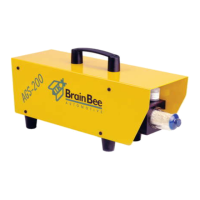ENGLISH 5 / 5 CHAP. 3 - SAFETY
gs-200
CHAP. 3 - SAFETY CONDITIONS
3.1 IMPORTANT INFORMATION CONCERNING PERSONAL SAFETY
DANGER OF ASPHYXIATION
PETROL (GASOLINE) FUELLED ENGINES
The exhaust gas of petrol (gasoline) fuelled engines contains carbon monoxide, a
colourless and odourless gas which can cause serious physical problems if inhaled.
Pay particular attention if you work in a pit as some exhaust gas components are
heavier than air and will thus deposit at the bottom of the pit itself.
Great care should also be taken with gas fuelled vehicles..
DIESEL ENGINES
The composition of the exhaust gas produced by a Diesel engine is not always the
same. It can change according to: the type of engine, aspiration, the conditions of use
and the composition of the fuel used.
Diesel exhaust consists of (CO, CO2, NOX and HC) gas and particulate (soot,
sulphates).
The tiny particles of carbon that form the soot remain suspended in the air and can
therefore be inhaled. Small amounts of toxic components are also present.
SAFETY MEASURES:
- Always ensure that the place in which you work is correctly ventilated and that any
fumes are exhausted (particularly in pits).
- Always operate the exhaust system in closed rooms..
DANGER OF BEING CRUSHED
You could be crushed against a work bench unless the vehicles are correctly locked in
place by mechanical means.
SAFETY MEASURES:
- Make sure that the vehicle is unable to move by applying the hand brake and locking
the wheels.
- Allow the engine to cool.
- Do not use naked flames or components that produce sparks.
- Do not smoke.

